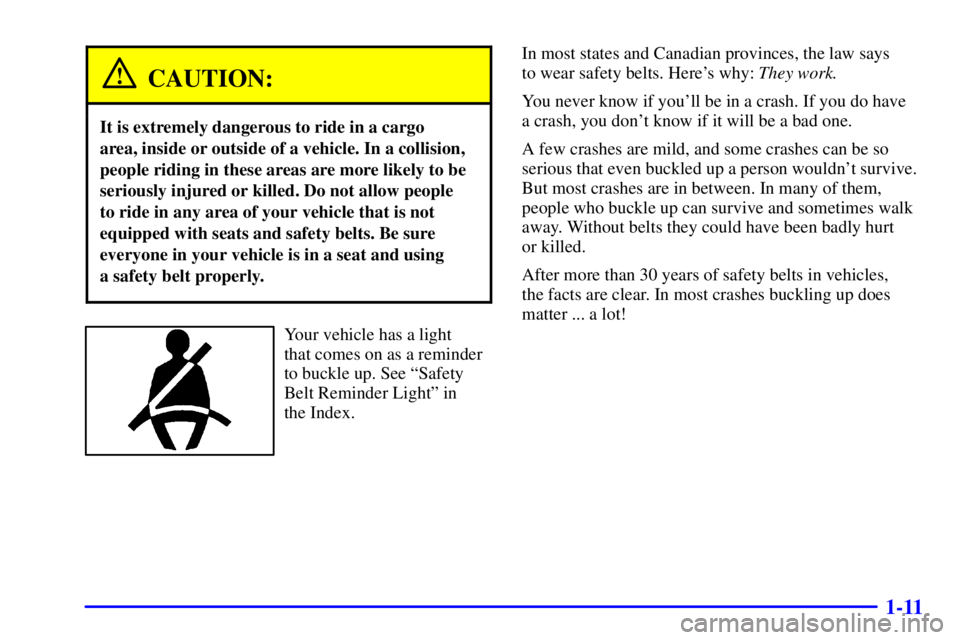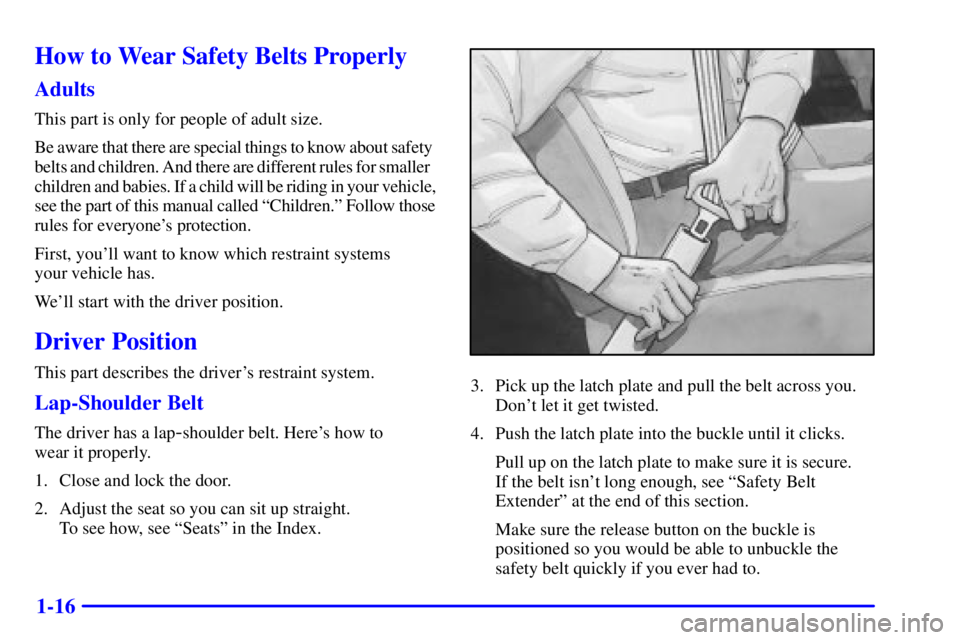Page 8 of 411
1-
1-1
Section 1 Seats and Restraint Systems
Here you'll find information about the seats in your vehicle and how to use your safety belts properly. You can also
learn about some things you should not do with air bags and safety belts.
1
-2 Seats and Seat Controls
1
-10 Safety Belts: They're for Everyone
1
-15 Here Are Questions Many People Ask About
Safety Belts
-- and the Answers
1
-16 How to Wear Safety Belts Properly
1
-16 Driver Position
1
-24 Safety Belt Use During Pregnancy
1
-25 Right Front Passenger Position
1
-25 Air Bag System
1
-34 Rear Seat Passengers1
-36 Rear Safety Belt Comfort Guides for
Children and Small Adults
1
-39 Center Passenger Position
1
-40 Children
1
-46 Restraint Systems for Children
1
-61 Older Children
1
-64 Safety Belt Extender
1
-64 Checking Your Restraint Systems
1
-64 Replacing Restraint System Parts
After a Crash
Page 9 of 411
1-2
Seats and Seat Controls
This part tells you about the seats -- how to adjust them,
take them out and put them back in. It also tells you
about reclining front seatbacks.
Manual Front Seats
The bucket seats can be adjusted forward or rearward
with the lever located at the front of the seat.To adjust the seat, pull the lever up to release the seat
bottom. Slide the seat to where you want it and then
release the lever. Try to move the seat with your body,
to make sure the seat is locked into place.
CAUTION:
You can lose control of the vehicle if you try to
adjust a manual driver's seat while the vehicle is
moving. The sudden movement could startle and
confuse you, or make you push a pedal when you
don't want to. Adjust the driver's seat only when
the vehicle is not moving.
Page 12 of 411
1-5 Rear Seats
Getting Into the Rear Seats
To make it easier for passengers to get into the rear
seats, use the fastener spot on the headliner and safety
belt sleeve. These will keep the safety belts out of the
way while people get into the rear seats.
Removing the Rear Seat
1. Disconnect the quick release latch plates for the
lap shoulder belts on the bench seat to be removed.
To do this, press the tip of a key into the release
hole of the safety belt buckle while pulling up on
the safety belt.
Page 15 of 411
1-8
For the remaining rear seats, stow the safety belt
latch plate on the clip at the window trim.Replacing the Rear Seats
CAUTION:
A seat that isn't locked into place properly can
move around in a collision or sudden stop. People
in the vehicle could be injured. Be sure to lock
the seat into place properly when installing it.
CAUTION:
A safety belt that is improperly routed, not
properly attached, or twisted won't provide
the protection needed in a crash. The person
wearing the belt could be seriously injured.
After installing the seat, always check to be sure
that the safety belts are properly routed and
attached, and are not twisted.
Page 18 of 411

1-11
CAUTION:
It is extremely dangerous to ride in a cargo
area, inside or outside of a vehicle. In a collision,
people riding in these areas are more likely to be
seriously injured or killed. Do not allow people
to ride in any area of your vehicle that is not
equipped with seats and safety belts. Be sure
everyone in your vehicle is in a seat and using
a safety belt properly.
Your vehicle has a light
that comes on as a reminder
to buckle up. See ªSafety
Belt Reminder Lightº in
the Index.In most states and Canadian provinces, the law says
to wear safety belts. Here's why: They work.
You never know if you'll be in a crash. If you do have
a crash, you don't know if it will be a bad one.
A few crashes are mild, and some crashes can be so
serious that even buckled up a person wouldn't survive.
But most crashes are in between. In many of them,
people who buckle up can survive and sometimes walk
away. Without belts they could have been badly hurt
or killed.
After more than 30 years of safety belts in vehicles,
the facts are clear. In most crashes buckling up does
matter ... a lot!
Page 23 of 411

1-16
How to Wear Safety Belts Properly
Adults
This part is only for people of adult size.
Be aware that there are special things to know about safety
belts and children. And there are different rules for smaller
children and babies. If a child will be riding in your vehicle,
see the part of this manual called ªChildren.º Follow those
rules for everyone's protection.
First, you'll want to know which restraint systems
your vehicle has.
We'll start with the driver position.
Driver Position
This part describes the driver's restraint system.
Lap-Shoulder Belt
The driver has a lap-shoulder belt. Here's how to
wear it properly.
1. Close and lock the door.
2. Adjust the seat so you can sit up straight.
To see how, see ªSeatsº in the Index.
3. Pick up the latch plate and pull the belt across you.
Don't let it get twisted.
4. Push the latch plate into the buckle until it clicks.
Pull up on the latch plate to make sure it is secure.
If the belt isn't long enough, see ªSafety Belt
Extenderº at the end of this section.
Make sure the release button on the buckle is
positioned so you would be able to unbuckle the
safety belt quickly if you ever had to.
Page 43 of 411
1-36
CAUTION:
You can be seriously hurt if your shoulder belt is
too loose. In a crash, you would move forward too
much, which could increase injury. The shoulder
belt should fit against your body.
To unlatch the belt, just push the button on the buckle.
Rear Safety Belt Comfort Guides for
Children and Small Adults
Your vehicle may have rear shoulder belt comfort
guides. This feature will provide added safety belt
comfort for older children who have outgrown booster
seats and for small adults. When installed on a shoulder
belt, the comfort guide better positions the belt away
from the neck and head.
There is one guide for each outside passenger position
in the rear seats. To provide added safety belt comfort
for children who have outgrown child restraints and for
smaller adults, the comfort guides may be installed on
the shoulder belts. Here's how to install a comfort guide
and use the safety belt:
Page 46 of 411
1-39
Center Passenger PositionLap Belt
If your vehicle has rear bench seats, someone can sit in
the center positions.
When you sit in a center seating position, you have a
lap safety belt, which has no retractor. To make the belt
longer, tilt the latch plate and pull it along the belt.